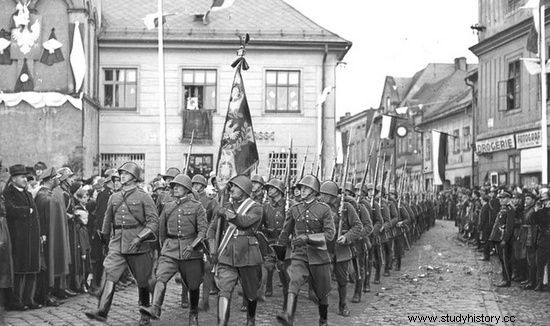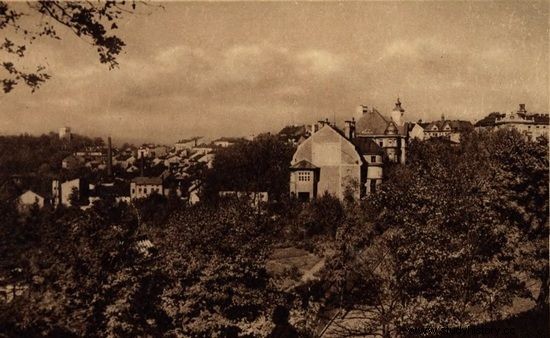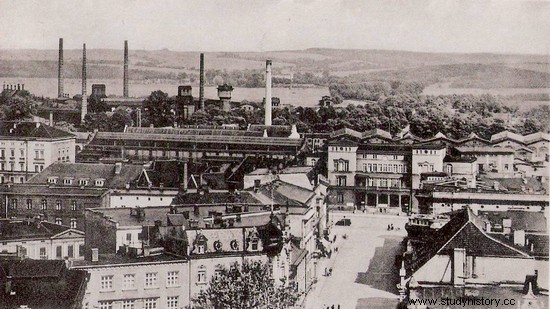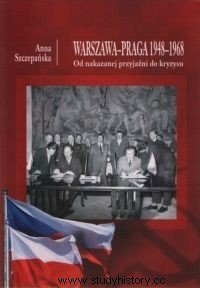Although World War II had just ended, troops ready to attack were concentrated on both sides of the disputed border. Both the Czechs and Poles were determined to fight for Kłodzko, Zaolzie and Racibórz. If Stalin had any merits for Central Europe, it was precisely to prevent a new war on the ruins of the Third Reich. Were it not for the intervention of the Soviet leader, the Polish Army would almost certainly have entered Czechoslovakia.
The disagreements between Poland and Czechoslovakia were by no means new. From 1918, we argued about Zaolzie, which was first occupied by the Czechs (against bilateral agreements, but with the consent of the Western powers), and then - taking advantage of the Nazi annexation of the Sudetenland - in 1938, the Poles recaptured. World War II meant that the dispute was temporarily put aside, but it was enough for both countries to regain their lost state, and the specter of a new - incomparably more serious - conflict appeared on the horizon.
First of all, it wasn't just about Zaolzie anymore. The list of disputes includes the division of post-German Lower Silesia and the topic of the return of border towns occupied by the Slovaks in 1939. The situation was by no means eased by the takeover of power in Poland by the communists.
Admittedly, they walked on the Stalinist belt, but at the same time had to fight for the support of the public. Giving away more territories - in addition to the entire Eastern Borderlands - could not help them in this. A successful fight for the expansion of borders, on the contrary.

The conflict over Zaolzie between Poland and Czechoslovakia continued throughout the interwar period. First, it was occupied by the Czechs, and in 1938 it was annexed to Poland.
Neighbors are getting ready for war
As Anna Szczepańska writes in the book "Warszawa-Praga 1948-1968", as early as March 1945, Polish activists in Zaolzie began to appeal to the Provisional Government of the Republic of Poland to join their paternity to the motherland.
The Minister of National Defense, Michał Rola-Żymierski, immediately responded to their call. He assured of Stalin's goodwill and help and about the readiness of the government to take a tough stance on Czechoslovakia on the proper course of the border.
In May, the Poles established their civic committees and national councils on the disputed territory, and the Operational Group "Zaolzie", composed of the soldiers of the Home Army, crossed the bridges over the Olza River. And then things got complicated :Contrary to Rola-Żymierski's announcements, the Red Army soldiers and the Czechs immediately disarmed Polish troops.

Cieszyn, a symbol of the Polish-Czechoslovak conflict.
The Provisional Government sent a memorandum to Stalin demanding the withdrawal of the Czech army and administration from the disputed area. Meanwhile, the Czechs began organizing the registration and displacement of the Polish population.
Although Czechoslovakia returned to Poland the villages on the border with Slovakia at the end of May, it quickly began spreading propaganda that the Slovaks were discriminated against or even persecuted by the Polish authorities.
On both sides there were riots, robberies and ethnic attacks. Both countries therefore had - in their own opinion - perfect excuses to attack.
Waiting for a signal to attack
In June, Poland sent further notes to the Czechoslovak government, this time announcing the use of force . June 16, quoting Anna Szczepańska:
the government in Warsaw called on Poles in Zaolzie not to submit to the registration campaign and leave their land, and assured that they would come to the rescue.
This article has more than one page. Please select another one below to continue reading.Attention! You are not on the first page of the article. If you want to read from the beginning click here.
The next day, the Polish army did indeed enter Cieszyn Silesia, and to Cieszyn itself came a supporter of hard solutions , the already mentioned minister Rola-Żymierski. 57 hectares have been occupied on the border with Czechoslovakia, waiting only for a decision on a further offensive.

In June 1945, Czech troops reached Racibórz. The war was literally in the balance.
The Czechs, for their part, carried out an intensive campaign to join their countries of Kłodzko and Racibórz. They did not intend to stick to the second city at all - on May 10, the Czechoslovak operational group reached the vicinity of the former German town, and only withdrew under pressure from the Soviet Union.

The Czechs, however, did not give up - at the end of May they sent diplomatic notes to Washington, Paris, London, Moscow and Warsaw, announcing that their army would take Kłodzko by force . On June 10, Czechoslovakia once again approached Racibórz.
The Polish authorities decided that the jokes were over:Bolesław Bierut sent the troops to the border, and Michał Rola-Żymierski handed the Czechoslovak MP a note demanding the withdrawal of troops. On June 17, Polish troops began the recovery of Kłodzko, and units in the Cieszyn region were ordered to attack Zaolzie . The war is in the balance.
Only then did Stalin firmly take part in the matter, averting the risk of an armed conflict by means of pressure and threats. Today, almost nobody remembers about the war with Czechoslovakia, but it was really close to its outbreak ...
Source:
Trivia is the essence of our website. Short materials devoted to interesting anecdotes, surprising details from the past, strange news from the old press. Reading that will take you no more than 3 minutes, based on single sources. This particular material is based on:
- Anna Szczepańska, Warsaw-Prague 1948-1968. From commanded friendship to crisis , Scientific Publishers of the University of Szczecin, 2011.
Check where to buy "Heart of Europe":
